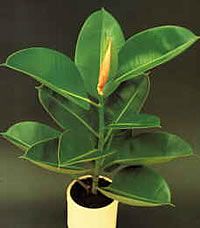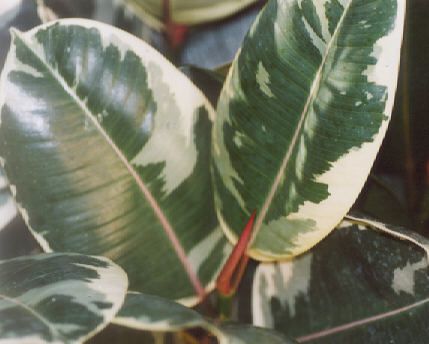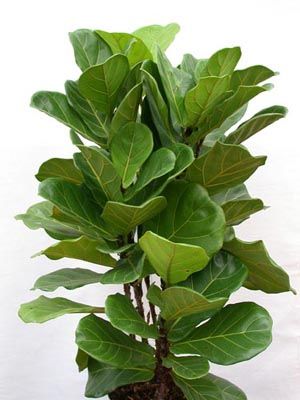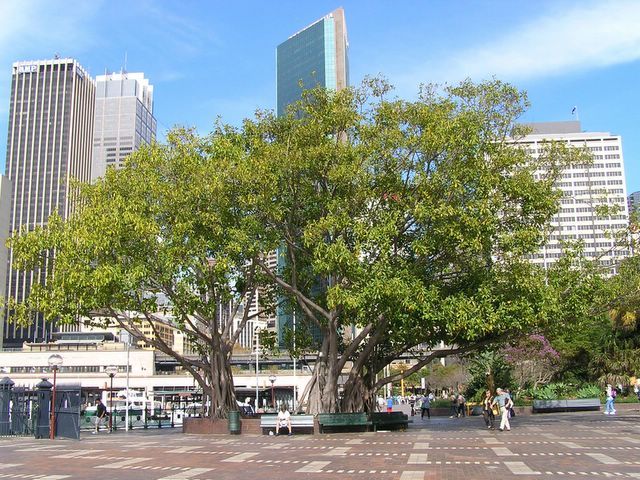Ficus



Common name: Rubber tree, India-Rubber Fig
Family: Moraceae
Description:
Often seen as an interior container plant, Rubber Tree has large, 5 to 12-inch-long, thick, glossy evergreen leaves, multiple trunks, and a spreading, irregular canopy. Able to reach 100 feet in height in its native habitat in the jungle but most often seen at about 25 to 40 feet in the landscape, Rubber Tree is useful as a screen, shade, patio, or specimen tree. Its coarse texture makes a strong statement in the landscape. Use as a street tree is limited by the tree's tendency to break apart in strong winds. Perhaps the tree could be made stronger by removing branches with weak tight-angle crotches and spacing major lateral branches along one central trunk. Eliminate multiple trunks early in the life of the tree and prune lateral branches so they remain smaller than half the diameter of the trunk to increase longevity in the landscape.

Care and cultivation:
Rubber plants like bright light, but never hot sun. When the new leaves are emerging, even less light is advisable, as this will promote larger leaves. Rubber plants are very susceptible to changes in environment, such as warm to a cool room. Keep them out of drafts, and away from heat ources. Keep your plant evenly moist during the growing cycle in spring and summer, but on the dryer side during the rest of the year. They really appreciate having their leaves sponged off with a damp cloth. When you fertilize your rubber plant in the spring and again in early summer, use a weak mixture of a soluble house plant food.
Rubber plants have a tendency to lose their lower leaves, usually from environmental reasons. If this happens very often, new shoots will emerge from the old leaf node. A very light nick, with a sharp, clean knife, right above the old node will often speed the new growth process from that point, but be sure to not cut to deeply.
It does well in many types of soil: clay, loam, sand, acidic, occasionally wet, alkaline, well-drained. It has high tolerance to drought.
Rubber Tree will grow quickly in sun or partial shade on almost any well-drained soil. The soil should be allowed to become fairly dry between waterings, especially in containers. Rubber Tree makes a nice house plant if it is not over-watered.
Pests and Diseases
No pests or diseases are of major concern but occasionally scales are a problem.
Species:
'Doescheri' has yellow-variegated leaves;
'Decora' produces broad, reddish-green leaves with ivory-colored veins running down center of leaf;
'Variegata' has light green leaves with white or yellow margins.
Articole asemănătoare
-
Smochinele, sursa de calciu, magneziu, potasiu si fier
Smochinele cresc pe copacul numit Ficus carica si sunt native din Orientul Mijlociu. In prezent la capitolul productie locul trei in lume este ocupat de California, dupa Turcia si Grecia.
-
Ficus - planta decorativa in apartamente
Pentru ficus taierea lastarilor sau ramurilor se realizeaza de obicei primavara, in lunile martie-aprilie
-
Ficus elastica
Planta are o tulpina verticala, care ramifica slab. Cresterea in inaltime si ramificarea se directioneaza prin taiere. Frunza, protejata de o bractee roz, are limbul de forma oval-eliptica, pielos, de culoare verde inchis, stralucitor.
-
Ficus religiosa
Tulpina ramifica bine, frunzele sunt relativ mari, lung petiolate, cu varful ascutit, subtiri, cu nervatiunea aproape alba, asemanatoare frunzelor de nuc.
-
Ficus bengalesis
Planta ramifica f puternic. Frunzele au foarma oval-rotunjita, sunt groase si au nervatiunea pronuntata. Se remarca prin culoarea maronie, pe partea inferioara.